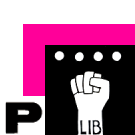User:Kim/reading/N. Katherine Hayles: Writing Machines: Difference between revisions
No edit summary |
|||
| (One intermediate revision by the same user not shown) | |||
| Line 1: | Line 1: | ||
'''MIT Press, 2002''' | |||
== chapter 2== | == chapter 2== | ||
'''Material metaphors, Technotexts and Media-Specific Analysis''' | '''Material metaphors, Technotexts and Media-Specific Analysis''' | ||
| Line 22: | Line 24: | ||
<blockquote> | <blockquote> | ||
word was interwoven with world | word was interwoven with world | ||
</blockquote> | |||
== chapter 4 == | |||
'''Electronic Literature as Technotext: Lexia to Perplexia''' | |||
* computers are more than hardware and software: they produce environments | |||
* hence the need for material metaphors, they control, direct and amplify traffic between physical actions and imaginative world a work creates | |||
<blockquote> | |||
reminding us that the computer is also a writer | |||
</blockquote> | |||
== chapter 6 == | |||
'''A Humument as Technotext: Layered Topographies''' | |||
<blockquote> | |||
Visually these rivers of whitespace trickle down the page, often branching into multiple pathways. Other devices creating hypertextual profusion are leaky borders. | |||
</blockquote> | |||
* two diemnsional page is stretched into something three dimensional, a topographic space | |||
* text as a space to explore rather than a line to follow | |||
== chapter 7 == | |||
'''Embodiments of Material Metaphors''' | |||
<blockquote> | |||
Even when the interface is rendered as transparent as possible, this very immediacy is itself an act of meaning-making that positions the reader in a specific material relationship | |||
</blockquote> | |||
<blockquote> | |||
The implication for studies of technologies and literature is that the materiality of inscription thoroughly interpenetrates the represented world. | |||
</blockquote> | </blockquote> | ||
Latest revision as of 21:56, 15 January 2025
MIT Press, 2002
chapter 2
Material metaphors, Technotexts and Media-Specific Analysis
- "metaphor" from root meaning "bearing across" (transfer of sense between two associated)
- Hayles coins Material Metaphor foregrounds relation/ back and forth between words and physical artifacts
- take the book for example, so obvious we barely recognize it:
- page defines a unit of reading
- binding pages indicates, fixates order of reading
- opacity of paper defining if page appears linear, sequencial or interpenetrating and simultaneous
- take the book for example, so obvious we barely recognize it:
- inscription technologies is device that initiate material changes that can be read as marks
- in print books: words are ink marks left on paper
- in computer text: computer changes electric polarities and correlates these changes with binary code
- Technotexts connects technology that produces texts to the texts verbal constructions
- parallels to Hypertetxts (follows min. 3 characteristics: multiple reading paths, chunked text and linking mechanism)
- media constantly engage in recursive dynamic of imitating each other
Media Specific Analysis insists that texts must always be embodied to exist in the world.
- materiality emerges from interactions between physical properties and a works artistic strategies
chapter 3
Entering the Electronic Environment
word was interwoven with world
chapter 4
Electronic Literature as Technotext: Lexia to Perplexia
- computers are more than hardware and software: they produce environments
- hence the need for material metaphors, they control, direct and amplify traffic between physical actions and imaginative world a work creates
reminding us that the computer is also a writer
chapter 6
A Humument as Technotext: Layered Topographies
Visually these rivers of whitespace trickle down the page, often branching into multiple pathways. Other devices creating hypertextual profusion are leaky borders.
- two diemnsional page is stretched into something three dimensional, a topographic space
- text as a space to explore rather than a line to follow
chapter 7
Embodiments of Material Metaphors
Even when the interface is rendered as transparent as possible, this very immediacy is itself an act of meaning-making that positions the reader in a specific material relationship
The implication for studies of technologies and literature is that the materiality of inscription thoroughly interpenetrates the represented world.
